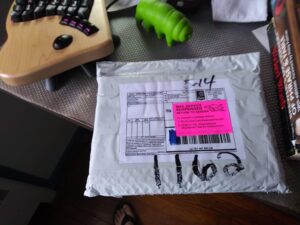Kris Rusch has a lovely blog post today on the need for courage in the writing business. I started to comment on it, but the comment grew to such a length that would be rude to leave it. “Comment” does not mean “lengthy diatribe.” So:
A key component of courage is the willingness to accept the risk of pain, and perhaps actual pain. Publishing is full of emotional pain. Every time I write something, I wonder if I should make it public. If I should put it out there. And then I remind myself of the very worst that could happen.
The Book Police will show up at my door with their lead-type-studded cudgels to drag me by my ankles to the front lawn of the Library of Congress, where they’ll put me in stocks for the day with a sign hanging around my neck declaring me a Bad Writer and place a bushel basket of rotten fruit a few feet away for amateur literary critics’ throwing pleasure, while simultaneously the Bad Art Correction Squad will break out their erasers and hard drive degaussers and eliminate all trace of my work from meatspace and Internet alike.
No–wait. That’s not it. Sorry.
The worst that can happen is nobody notices. Nobody cares. That the thing I spent hours or weeks or even months writing gets no attention and attracts zero readers.
That hurts. I’d rather take rotten nectarines to the face for a few hours.
As long as I don’t publish, my comforting dream of this book’s explosive success remains alive. I avoid the risk of pain.
Writers, especially new writers, believe that their books are special. I hear writers call their books their babies, their special friends, their precious. And it’s simply not true. Or worse, they don’t call their books that. They call their book (singular) that.
If you’ve just finished writing your first book, or your second, this is understandable. It’s even natural.
But it’s a terrible mindset for any artist.
Writing is a creative skill, like any other art. You can learn to write just as you can learn to paint or throw clay or staple yourself to the world’s largest ball of string and have your friends set you rolling down the freeway and call it performance art. A potter would not expect to find success from their first successful vase. A painter would not expect their first portrait to win awards. No, these creators finish a piece, take a moment to appreciate and contemplate it, and start on the next one.
Successful writers are the same way.
Don’t get me wrong, the dream of success is great. The dream of fame and glory and supple book groupies can keep you going.
But being a writer is about being able to take a punch and either laugh it off or full-on ignore it. I’m a full time writer, and not a week goes by that I don’t get a scathing review from someone who didn’t read the book description or even look at the cover. (Don’t read your reviews. Seriously.)
Is that email from an unfamiliar sender spam? Or is it a vitriolic screed against one of my books or my entire career? Is it from someone who read the Immortal Clay novels and wants to helpfully inform me that I require intensive therapy, immediately and preferably inpatient, as if every single person who’s ever met me hasn’t already informed me? It might be from someone offering me money, so I guess I better open it.
People who’ve previously said they loved my books take lengthy detours to tell me this latest one is not up to scratch, but they figure I needed the money.
Being ignored hurts. Being noticed hurts more. Writers must have the courage to face the risk of emotional pain. Just as with athletic pain, critical pain gets easier to cope with the more you overcome it. It doesn’t get better. You grow stronger.
Yes, we all want our books to be noticed. To achieve success. The only way to make that dream reality is to consciously, deliberately, and with premeditation murder it and accept the risk. Your work cannot succeed so long as you hide it.
If you can’t accept the risk, feel free to cuddle your dream. Just don’t complain to any pro author about it. We want to help folks who are willing to take the necessary hits.
You’re willing to face the pain, but you need that dream of supple book groupies to keep you going? You need hope? That’s not only dandy, that’s human. Hope is the greatest gift.
But make a new dream for each book. Even if it’s the same old dream with the serial numbers filed off.
By the time I publish one book, I’ve already started writing the next book. The published book will live or die as readers dictate. But the book I’m halfway through writing right now? That one’s gonna hit big. I guarantee it.
I’m a potter fondling the next lump of freshly-scooped raw clay, convinced that this next piece will be my greatest triumph.







